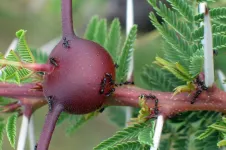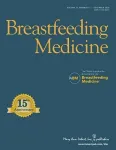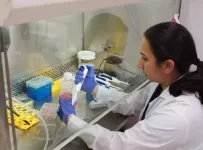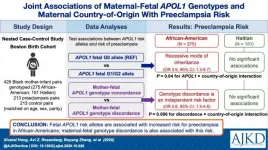Beating the 'billion-dollar bug' is a shared burden
Study shows how individual farming practices associated with greater corn rootworm damage can have farther-reaching effects
2021-01-12
(Press-News.org) A lurking threat that has stymied US corn growers for decades is now returning to the forefront: western corn rootworm. Sometimes referred to as the "billion-dollar bug," the species' tiny larvae chew through the roots of corn plants, causing devastating yield losses. In 2003, farmers began planting a genetically engineered variety of corn known as "Bt," which produces a protein toxic to the pest species - but by 2009, the billion-dollar bug had already evolved adaptations for resistance to the toxin.
A new study suggests that slowing the resurgence of western corn rootworm may require a larger-scale strategy than previously thought. The findings, which were published in the Ecological Society of America's journal Ecological Applications, show that when farmers do not follow best management practices for mitigating corn rootworm within a field, they also jeopardize surrounding fields.
Primary author Coy St. Clair and his colleague Aaron Gassmann pinpointed 64 "problem fields" across Iowa, where western corn rootworm had caused greater-than-expected levels of injury to corn between 2009 and 2013 in two varieties of Bt maize: Cry3Bb1 and mCry3A. Compared to fields where rootworm had not damaged Bt maize, the problem fields had higher levels of continuous maize cultivation in surrounding buffer areas.
Corn rows as far as the eye can see in Buchanan County, Iowa. Original image from Carol M. Highsmith's America, Library of Congress collection. Digitally enhanced by rawpixel.
Regular crop rotation is a key strategy for interfering with rootworm's life cycle: when rootworm eggs hatch in a field without corn, the larvae starve before they have a chance to mature and lay eggs. However, continuous planting of corn tends to be more profitable in the short term, leaving corn growers with difficult decisions about how to manage risks.
St. Clair, now a research entomologist for Genective (Champaign, Ill.) who conducted the research as a Ph.D. student at Iowa State University, says that the story of western corn rootworm resistance to Bt illustrates that pest mitigation is a shared responsibility. "If the pest remains susceptible, everyone benefits. If resistance develops, everyone suffers."
Continuous maize cultivation gives nascent rootworm populations a chance to evolve resistance to the Bt toxin - and for those newly resistant offspring to travel to other fields.
"The takeaway here is that a farmer who is employing best management practices - such as frequent crop rotation, or planting of non-Bt maize - will effectively manage rootworm and delay resistance in their own field firstly, while simultaneously helping to delay resistance development in surrounding populations secondly," explained St. Clair. "Conversely, a farmer who is planting multiple years of the same trait will risk resistance in their own field, while contributing to the depletion of the shared resource of trait susceptibility."
As of 2020, agronomists have confirmed that populations of western corn rootworm resistant to the two Bt traits examined in the study are present across the US corn belt, along with two additional Bt traits.
INFORMATION:
Journal article:
St. Clair, Coy, and Gassmann, Aaron, 2021. "Linking Land Use Patterns and Pest Outbreaks in Bt Maize." doi.org/10.1002/eap.2295
Authors:
Coy St. Clair and Aaron Gassman
Department of Entomology, Iowa State University, Ames, IA, USA
Author contact:
Coy St. Clair (coyray03@gmail.com)
The Ecological Society of America, founded in 1915, is the world's largest community of professional ecologists and a trusted source of ecological knowledge, committed to advancing the understanding of life on Earth. The 9,000 member Society publishes five journals and a membership bulletin and broadly shares ecological information through policy, media outreach, and education initiatives. The Society's Annual Meeting attracts 4,000 attendees and features the most recent advances in ecological science. Visit the ESA website at https://www.esa.org.
[Attachments] See images for this press release:
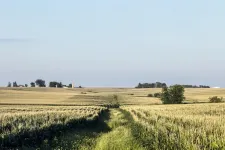
ELSE PRESS RELEASES FROM THIS DATE:
2021-01-12
BOSTON - While investigating the underlying causes of a rare skin disorder, a researcher at Massachusetts General Hospital (MGH) discovered a previously unknown mechanism in the kidneys that is important for regulating levels of magnesium and calcium in the blood.
The discovery, described in the journal Cell Reports, highlights the role of a previously little-studied gene called KCTD1. The gene directs production of a protein that regulates the kidney's ability to reabsorb magnesium and calcium from urine and return it to the bloodstream.
A genetic mutation causing the loss of KCTD1 results in defects in nephrons, ...
2021-01-12
You've heard of Old Faithful, the Yellowstone National Park geyser that erupts every hour or two, a geological phenomenon on a nearly predictable schedule.
Now, an international group of scientists who study space have discovered an astronomical "Old Faithful" - an eruption of light flashing about once every 114 days on a nearly predictable schedule. The researchers believe it is a tidal disruption event, a phenomenon that happens when a star gets so close to a black hole that the black hole "rips" away pieces of the star, causing the flare.
The team made the discovery using data from NASA and from a network of telescopes operated by The Ohio State University.
Their findings, presented today at the Astronomical Society's annual meeting and accepted for publication ...
2021-01-12
Researchers have found a simple way to eliminate almost all sequencing errors produced by a widely used portable DNA sequencer, potentially enabling scientists working outside the lab to study and track microorganisms like the SARS-CoV-2 virus more efficiently.
Using special molecular tags, the team was able to reduce the five-to-15 per cent error rate of Oxford Nanopore Technologies' MinION device to less than 0.005 per cent -- even when sequencing many long stretches of DNA at a time.
"The MinION has revolutionized the field of genomics by freeing DNA sequencing from the confines of large laboratories," says Ryan Ziels, an ...
2021-01-12
Scientists have used gene-editing advances to achieve a tenfold increase in the production of super-bug targeting formicamycin antibiotics.
The John Innes Centre researchers used the technology to create a new strain of Streptomyces formicae bacteria which over-produces the medically promising molecules.
Discovered within the last ten years, formicamycins have great potential because, under laboratory conditions, superbugs like MRSA do not become resistant to them.
However, Streptomyces formicae only produce the antibiotics in small quantities. This has made it difficult to scale up ...
2021-01-12
ITHACA, NY - Invasive round goby fish have impacted fisheries in the Great Lakes and the Finger Lakes by competing with native species and eating the eggs of some species of game fish.
But the camouflaged bottom dwellers can be difficult to find and collect - especially when they first enter a new body of water and their numbers are low and they might be easier to remove.
In a proof-of-principle study, Cornell researchers describe a new technique in which they analyzed environmental DNA - or eDNA - from water samples in Cayuga Lake to gather nuanced information about the presence of these invasive fish.
The study, "Nuclear eDNA Estimates Population Allele Frequencies and Abundance in Experimental Mesocosms and Field Samples," was ...
2021-01-12
In a large population-based family study, family history of kidney disease was strongly associated with increased risk of chronic kidney disease.
In this large population-based family study recently published in the American Journal of Kidney Diseases, researchers investigated the familial aggregation of CKD by comparing the risk of chronic kidney disease (CKD) in individuals with an affected first-degree relative to that in the general population. Participants with an affected first-degree relative were observed to have a threefold higher risk of CKD compared to that in the general population, independent of BMI, hypertension, diabetes, hypercholesterolemia, history of cardiovascular disease (CVD), and smoking status. ...
2021-01-12
New Rochelle, NY, January 12, 2021--The Academy of Breastfeeding Medicine (ABM) does not recommend cessation of breastfeeding for individuals who are vaccinated against COVID-19. In a new statement, the ABM suggests that lactating women discuss the risks and benefits of vaccination with their health care provider, within the context of their risk of contracting COVID-19 and of developing severe disease, according to the peer-reviewed journal Breastfeeding Medicine. Click here to read the ABM statement now.
This is a challenging topic because the vaccine trials excluded lactating women. Thus, there are no clinical data regarding the safety ...
2021-01-12
The body's immune system is the first line of defense against infections like bacteria, viruses or cancers. Some cancers, however, have developed the art of molecular deception to avoid destruction by the body's immune system. However, a University of Missouri researcher might have found a new way to help the body's immune system get past that deception and destroy the cancer.
"Normally, your body's immune cells are constantly on patrol to identify and destroy foreign entities in the body," said Yves Chabu, an assistant professor in the Division of Biological Sciences. "Normal cells put up a 'don't-eat-me' molecular ...
2021-01-12
Acknowledging that COVID-19 may be here to stay, Oregon Health & Science University has laid out a series of steps to prepare patients for elective surgery following their illness.
The evaluation, outlined in a commentary published in the journal Perioperative Medicine, is believed to be the first published protocol laying out a COVID-era path forward in American medicine.
"We think this is groundbreaking," said senior author Avital O'Glasser, M.D., associate professor of medicine (hospital medicine) in the OHSU School of Medicine. "We are hoping other clinics and surgical centers can use this to keep their patients safe."
The work started around Memorial Day, when OHSU clinicians began to see an increasing number of patients ...
2021-01-12
Fetal APOL1 kidney risk alleles are associated with increased risk for preeclampsia in African Americans and maternal fetal genotype discordance is also associated with this risk.
Preeclampsia, characterized by increased blood pressure after 20 weeks of pregnancy, as well as other abnormalities (e.g., protein in the urine), is dangerous to mothers and their infants. Previous studies found that individuals with African ancestry may carry APOL1 genetic variants that increase risk for chronic kidney disease. This study published in the American Journal of Kidney Diseases (AJKD) found that fetal high-risk APOL1 genotypes and maternal-fetal APOL1 genotype discordance independently contribute to preeclampsia risk in African-American mothers. This ...
LAST 30 PRESS RELEASES:
[Press-News.org] Beating the 'billion-dollar bug' is a shared burden
Study shows how individual farming practices associated with greater corn rootworm damage can have farther-reaching effects

